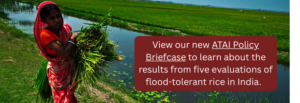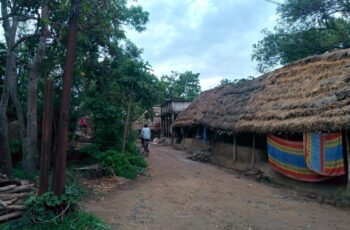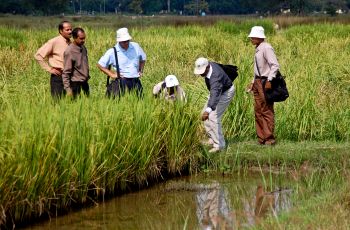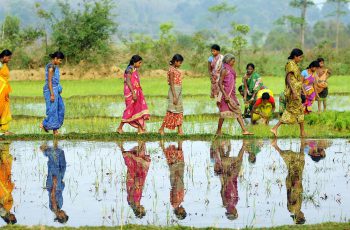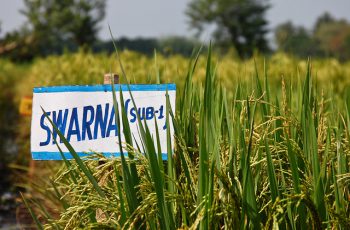Why Farmers and Scientists Farm Differently: Q&A with Kyle Emerick and Betty Sadoulet
Since 2009, ATAI has facilitated 85 research investments contributing to a rigorous evidence base on poverty reduction and agricultural development. In this blog, Jenna Fahle, agricultural program manager at CEGA, interviews Elisabeth (Betty) Sadoulet (UC Berkeley) and Kyle Emerick (Tufts) about their work on flood-tolerant rice in India.
Flooding poses a major hazard for farmers worldwide, with an estimated 66 million people in India alone who live on less than $1.90 a day and face regular risk of flooding[1]. In 2011, ATAI funded research on Swarna-Sub1, a revolutionary rice variety developed to withstand these conditions. While conventional rice varieties typically die after 3-4 days underwater, Swarna-Sub1 can survive submersion for up to two weeks.
Scientists, many at the International Rice Research Institute, had identified the gene responsible for this remarkable trait and transferred it into the widely grown Swarna variety. However, the variety had not yet been tested with farmers under real-world conditions.
Researchers Alain de Janvry and Elisabeth Sadoulet, in collaboration with co-authors Kyle Emerick and Manzoor Dar, designed a two-year, randomized evaluation in Odisha, India to understand the effects of Swarna-Sub1 on yields and farmer behavior.
What began as a single study evolved into over a decade of impact evaluation research, examining topics ranging from effective agricultural extension to how social structures affect technology adoption. This conversation with Kyle Emerick and Elisabeth (Betty) Sadoulet explores their work on Swarna-Sub1.
This research on Swarna-Sub1 demonstrates the ability for improved seeds to address weather-based risk for vulnerable farmers. However, the existence of improved seeds alone doesn’t necessarily translate to poverty reduction or income gains. How do you view the promises (and pitfalls) of improved seeds?
Emerick: Not all improved seed varieties are beneficial. When some varieties are improved in one dimension, they’re worse on another dimension, so that limits them from being widely adopted. For example, take a high-yielding seed variety that has poor grain quality. That is not going to be adopted because market prices will reflect the lower demand for the eating quality. Improved seed varieties that offer their target attribute, but keep farmers as well-off on the other attributes, are the ones that are most beneficial.
“Improved seed varieties that offer their target attribute, but keep farmers as well-off on the other attributes, are the ones that are most beneficial.”
Sadoulet: It is very rare to have an improved variety that dominates on all fronts. Swarna-Sub1 happened to be one of them. In addition, new varieties are usually only slightly improved compared to the previous release — progress moves by tiny steps, even though cumulative improvement over the years may be important. This means that it will be very difficult to evaluate the impact of a new variety, this is a very demanding exercise, all the more that results may have been obtained in different conditions, under a very special good year, and so forth.
On that note, why was it crucial to test Swarna-Sub1 in real-world farming conditions, beyond the agronomic trial setting?
Emerick: This is particularly important for a technology like Swarna-Sub1. In researcher-managed field trials, the inputs are highly controlled. In reality, part of the impact of many technologies is that farmers re-optimize with their inputs or management strategies, and that contributes to the impact. With the original Swarna-Sub1 study, one of the things we found is that farmers do re-optimize. They use more fertilizer and change how they plant, and that drives the impact of the technology. If you control those things in a researcher-managed trial, you’re unable to pick those effects up.
Sadoulet: There is a huge difference between the optimization that scientists can do and what farmers can do. Farmers don’t farm the way scientists farm. We really need to test the variety as it would be cultivated by the farmers given their constraints.
“Farmers don’t farm the way scientists farm.”
Can you talk about the early days of this research partnership?
Emerick: After my first year as a PhD student, I spent a summer in the Philippines. During that time, while talking to various people at IRRI (this was probably 2010 or so), Sub1 just continued to come up.The academic literature at that point was heavily focused on index insurance as a risk management tool. So we saw this is a good opportunity to study how a new technology could potentially play a role.
I remember lots of times in Giannini talking to Betty and Alain, and they said “Look, we need to figure out a way to understand if it is about risk.” We learned that farmers use different types of fertilizer based on plant needs. I remember being pushed to think deeply about what’s going on beyond the basic results. That first experience had a huge impact on me. Now, with my own students, I’m always asking, “What’s next? Why this? Why not this?” It makes it fun to understand what’s behind the results.
“That first experience had a huge impact on me. Now, with my own students, I’m always asking, “What’s next? Why this? Why not this?””
Over the course of this research, what findings have been most surprising or counterintuitive to you and why?
Emerick: The biggest surprise for me in the whole Swarna-Sub1 adventure came in our most recent paper about an agro-dealer-based extension experiment. Most people’s prior beliefs were that agro-dealers would push seeds to any farmers, regardless of whether the benefits for those farmers are large or small. We found that the agro-dealer-based extension not only increased adoption, but it increased it the most for farmers who are more exposed to flooding — those farmers who would benefit the most from the technology. In this setting, seed suppliers are highly local. They often sell to a handful of villages, their own included. When you step back and think about it, the system is actually set up for agro-dealers to promote technologies to farmers who could benefit most because it’s a very long-term relationship.
Despite the promise, Swarna-Sub1 has not yet reached its full adoption potential. What do you take from this, and where should research go next?
Sadoulet: I’m still puzzled as to why, in this rare case where Swarna-Sub1 is a dominant variety relative to Swarna, it has not completely replaced Swarna. There was no downside to adopting, except maybe buying it the first time. Before we do any more RCTs or empirical work and try to push this further, we just have to take the time to understand and get the facts right. Is it credit? Is it supply? We often don’t do the preliminary work that needs to be done.
“I’m still puzzled as to why, in this rare case where Swarna-Sub1 is a dominant variety relative to Swarna, it has not completely replaced Swarna.”
Emerick: One thing that comes to mind here is that in a few of the studies where we (the researchers) have been a source of supply — making the seed locally available with the purpose of revealing demand — we found pretty high adoption rates of Sub1. I think there are a lot of questions to be answered on the supply side. We could probably learn a lot more there.
Anything else to add?
Sadoulet: It’s important when you do field work and RCTs not just to say what works and what doesn’t work, but to tie it to some theory, and that’s what we’ve been doing all this time. It’s not just to see whether or not a technology was adopted, but to show that it’s a response to risk that the seed is adopted—that the demand is higher in response to risk. There was a lot of verification of theory about behavior towards risk, and that’s far more important than simply determining if they adopt or not and why.
[1] https://pmc.ncbi.nlm.nih.gov/articles/PMC6886445/
